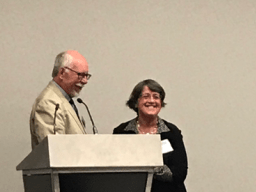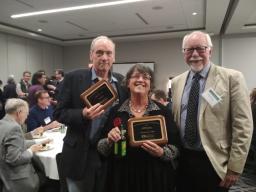American Society for Environmental History Awards Night 13 April 2019
Citation for the Distinguished Career in Public Environmental History
The award for Distinguished Career in Public Environmental History is presented every two years to an individual who has promoted environmental history to the public over time. This year’s award honors not one person, but two: Libby Robin and Tom Griffiths, whose partnership in life and work has helped make environmental history part of the public discourse in Australia and New Zealand.

Professor Robin is an historian of science and environmental ideas whose wide-ranging publications and projects of public engagement have explored conservation history and policy, museums in the Anthropocene, scientific expertise, climate change and the humanities, and much more.
Recently retired from her Professorship at the Fenner School of Environment and Society at the Australian National University, Dr. Robin has worked both locally and far from home to spread understanding of the ecological humanities, from a long stint as a Senior Fellow in the National Museum of Australia's Research Centre (2007-2015), to two multi-year stretches as a visiting and affiliated faculty member at the Royal Institute of Technology in Stockholm. She is also an advisor to the Center for Environmental History (KAJAK) at Tallinn University in Estonia.
Libby’s international efforts have also included fostering relationships around the globe among scholars and professionals in numerous fields. She is part of the Executive of the International IHOPE Project: An Integrated History and Future of People on Earth; More than twenty years ago, she paid out of her own pocket to launch the Australia-New Zealand Environmental History Network, which continues to this day. Together with Verena Winiwarter, Steve Anderson, Jane Carruthers, and many others, she was also one of the founding organizers of the dynamic and growing International Consortium of Environmental History Organizations (ICEHO), of which she is the immediate past president and ongoing Bulletin editor. In 2014, Libby established with Thom Van Dooren the Australian Environmental Humanities Hub, a website for sharing and coordinating news and events in the field, with members and advisors from Taiwan to Iceland.
Libby’s partner, Tom Griffiths work has also had wide-ranging impact. As the recently retired William Keith Hancock Professor of History in the Australian National University School College of Arts and Social Sciences and Director of the Centre for Environmental History at ANU, Tom’s research, writing, teaching and research have looked at the comparative environmental history of settler societies, the history of Antarctica, and the social, environmental, and cultural history of Australia.
His projects include an investigation of Australian engagement in the Antarctic Treaty System; Climate and Culture in Australia; and the ongoing Victorian Bushfire Project, a collaborative response to the devastating Black Saturday bushfires that roared across Steels Creek, Australia ten years ago. The collaboration between the Centre for Environmental History, Steels Creek community, and survivors of the fire emphasizes how environmental history can help heal people after a traumatic experience. Integrating understandings of the fire’s social, cultural and ecological dimensions, the project’s efforts are all the more timely and alarmingly relevant as climate change is bringing longer, hotter, and more ferocious fire seasons around the world, from Australia and the Americas to Europe and even north of the Arctic Circle .
Libby and Tom are both Fellows of the Australian Academy of Humanities. They have more publications and international and Australian prizes between them than it would be possible to list in this session. Together, they have organized numerous doctoral workshops for students from all over Australia, in which many ASEH members and scholars have participated.
Selfless and not self-promoting, in efforts both complementary and collaborative, Libby and Tom have worked tirelessly to establish environmental history in the public understanding in Australia, and their efforts have borne fruit far afield, as well. They have integrated antipodean perspectives and research into the international environmental discourse, as we see in so many contributions at this year’s ASEH conference and at the ICEHO and ESEH meetings, as well.
Without them, as Christof Mauch has noted, Australia environmental history might still be terra incognita.
It is my pleasure, therefore, to give this year’s Distinguished Career in Public Environmental History award to Libby Robin and Tom Griffiths.

Libby travelled to Columbus Ohio to receive the award from ASEH President, Graeme Wynn (left), on behalf of them both.

